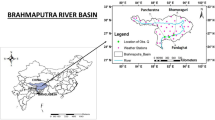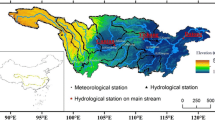Abstract
The Yalong River basin (YRB), originating from the Tibetan Plateau, is critical for China's western development and electricity transmission. Climate change would affect the streamflow and potentially impact the hydropower in the YRB. In this study, the Automated Statistical Downscaling technique and the hydrological model SWAT were used to reproduce the observed precipitation, temperature and streamflow and predict them in the future. More importantly, the Bayesian Model Averaging (BMA) method was used to appraise the performance of four different Global Climate Models (GCMs) in simulating historical streamflow (1984–1997), and to quantify the uncertainties in future projections (2021–2100) under three Representative Concentration Pathways (RCPs) in the YRB. It was found that (i) the SWAT hydrological model has good applicability in the YRB; (ii) the BMA method can capture the historical streamflow reasonably better than individual GCM projections, providing a scientific reference for the future water resources planning and utilization in the YRB.







Similar content being viewed by others
References
Abbaspour KC (2011) SWAT-CUP4: SWAT calibration and uncertainty programs—a user manual. Swiss Federal Institute of Aquatic Science and Technology, Eawag
Abbaspour KC, Faramarzi M, Ghasemi SS, Yang H (2009) Assessing the impact of climate change on water resources in Iran. Water Resour Res 45:1–16
Allen RG, Jensen ME, Wright JL, Burman RD (1989) Operational estimates of reference evapotranspiration. Agron J 81:650–662
Andaryani S, Nourani V, Trolle D, Dehgani M, Asl AM (2019) Assessment of land use and climate change effects on land subsidence using a hydrological model and radar technique. J Hydrol 578:124070
Arnold JG, Moriasi DN, Gassman PW et al (2012) Swat: model use, calibration, and validation. Am Soc Agric Biol Eng 55:1491–1508
Arora VK, Boer GJ (2001) Effects of simulated climate change on the hydrology of major river basins. J Geophys Res 106(D4):3335–3348
Bhat KS, Haran M, Terando A, Keller K (2011) Climate projections using Bayesian model averaging and space–time dependence. J Agric Biol Environ Stat 16(4):606–628
Chen L, Liu C (2007) Impact of climate and land cover changes on runoff in the source region of the Yellow River. China Environ Sci 4:559–565
Chen Y, Yuan W, Xia J et al (2015) Using bayesian model averaging to estimate terrestrial evapotranspiration in china. J Hydro 528:537–549
Dong L, Xiong L, Yu K (2013) Uncertainty analysis of multiple hydrologic models using the Bayesian model averaging method. J Appl Math 2013:1–11
Duan Q, Phillips TJ (2010) Bayesian estimation of local signal and noise in multimodel simulations of climate change. J Geophys Res 115(D18):D18123
Dvorak V, Hladny J, Kasparek L (1997) Climate change hydrology and water resources impact and adaptation for selected river basins in the Czech Republic. Clim Change 36:93–106
Faith G, Wilson G, Francis M, Willy B (2009) Climate change impact on SWAT simulated streamflow in western Kenya. Int J Climatol 29:1823–1834
Giorgi F, Mearns LO (2002) Calculation of average, uncertainty range, and reliability of regional climate changes from AOGCM simulations via the “reliability ensemble averaging” (REA) method. J Clim 15(10):1141–1158
Giorgi F, Mearns LO (2003) Probability of regional climate change based on the Reliability Ensemble Averaging (REA) method. Geophys Res Lett 30(12):1–4
Hargreaves GL, Hargreaves GH, Riley JP (1985) Agricultural benefits for Senegal River Basin. J Irrig Drain E-ASCE 111(2):113–124
Hessami M, Gachon P, Ouarda TBMJ, St-Hilaire A (2008) Automated regression-based statistical downscaling tool. J Environ Model Softw 23(6):813–834
Hoeting JA, Madigan D, Raftery AE, Volinsky CT (1999) Bayesian model averaging: a tutorial. Stat Sci 14(4):382–401
Houghton JT (2001) Climate change: the scientific basis: contribution of Working Group l to the third assessment report of the Intergovernmental Panel on Climate Change. Cambridge University Press, Cambridge, UK
IPCC (2001) Climate change 2001: the scientific basis. Summary for policymakers and technical summary of Working Group I Report. Cambridge University Press, Cambridge, UK
IPCC (2013) Climate change 2013: the physical science basis. In: Contribution of Working Group I to the fourth assessment report of the intergovernmental panel on climate change. University Press, Cambridge, UK
Lambert SJ, Boer GJ (2001) CMIP1 evaluation and inter-comparison of coupled climate models. Clim Dyn 17:83–106
Madadgar S, Moradkhani H (2014) Improved Bayesian multi-modeling: integration of copulas and Bayesian model averaging. Water Resour Res 50:9586–9603
Manabe S, Wetherald RT, Milly PCD, Delworth TL, Stouffer RJ (2004) Century-scale change in water availability: CO2-quadrupling experiment. Clim Change 64:59–76
McCuen RH (2016) Assessment of hydrological and statistical significance. J Hydrol Eng 21(4):2516001
Monteith JL(1965) Evaporation and environment proceedings of the 19th symposium of the society for experimental biology. Cambridge University Press, Cambridge, New York, pp 205–233
Moriasi DN, Arnold JG, Liew MWV, Bingner RL, Harmel RD, Veith TL (2007) Model evaluation guidelines for systematic quantification of accuracy in watershed simulations. Trans ASABE 50(3):885–900
Mujumdar PP, Ghosh S (2008) Modeling GCM and scenario uncertainty using a possibilistic approach: application to the Mahanadi River, India. Water Resour Res 44:1–15
Nash JE, Sutcliffe JV (1970) River flow forecasting through conceptual models Part I—a discussion of principles. J Hydrol 10(3):282–290
Piniewski M, Kardel I, Gielczewski M, Marcinkowski P, Okruszko T (2014) Climate change and agricultural development: adapting polish agriculture to reduce future nutrient loads in a coastal watershed. Ambio 43(5):644–660
Priestley CHB, Taylor RJ (1972) On the assessment of surface heat flux and evaporation using large-scale parameters. Mon Weather Rev 100(2):81–92
Qi H, Wen X (2019) Spatiotemporal variability in future extreme temperatures and rainfall in the Yangtze River Basin: update using Bias-Corrected climate projections fitted by stationary and nonstationary model. J Hydrol Eng 24(11):1–16
Srinivas R, Singh AP, Dhadse K, Magner J (2020) Hydroclimatic river discharge and seasonal trends assessment model using an advanced spatio-temporal model. Stoch Environ Res Risk Assess 34:381–396
Su B, Huang J, Zeng X (2017) Impacts of climate change on streamflow in the upper Yangtze River basin. Clim Change 141:533–546
Sun S, Chen H (2014) Assessing the future hydrological cycle in the Xinjiang Basin, China, using a multi-model ensemble and SWAT model. Int J Climatol 34:2972–3298
Tebaldi C, Smith RL, Nychka D (2005) Quantifying uncertainty in projections of regional climate change: a Bayesian approach to the analysis of multi-model ensembles. J Clim 18(10):1524–1540
Varanou E, Gkouvatsou E (2002) Quantity and quality integrated catchment modeling under climate change with use of soil and water assessment tool model. J Hydrol Eng 7(3):228–244
Wallach D, Mearns LO, Ruane AC, Rötter RP, Asseng S (2016) Lessons from climate modeling on the design and use of ensembles for crop modeling. Clim Change 139:551–564
Wang B, Zeng L (2018) Using multi-model ensembles of CMIP5 global climate models to reproduce observed monthly rainfall and temperature with machine learning methods in Australia. Int J Climatol 38:4891–4902
Wilby RL, Hay LE, Leavesley GH (1999) A comparison of downscaled and raw GCM output: implications for climate change scenarios in the San Juan River basin, Colorado. J Hydro 225:67–91
Xiong LH, Wan M (2009) Indices for assessing the prediction bounds of hydrological models and application by generalized likelihood uncertainty estimation. Hydrolog Sci J 4(5):852–871
Xu R, Hu H (2019) Projected climate change impacts on future streamflow of the Yarlung Tsangpo-Brahmaputra River. Glob Planet Change 175:144–159
Yan X, Lu W, An YK, Wong W (2020) Assessment of parameter uncertainty for non-point source pollution mechanism modeling: a Bayesian-based approach. Environmental Pollution, 114570.
Yang H, Wang B (2011) Reducing biases in regional climate downscaling by applying Bayesian model averaging on large-scale forcing. Clim Dyn 39(9–10):2523–2532
Yang T, Hao X, Shao Q (2012) Multi-model ensemble projections in temperature and precipitation extremes of the Tibetan Plateau in the 21st century. Glob Planet Change 80:1–13
Yu L, Jia B, Wu S, Wu X, Xu P, Dai J, Wang F, Ma L (2019) Cumulative environmental effects of hydropower stations based on the water footprint method—Yalong river basin. China Sustainability 11(21):5958
Yuan Z, Xu J, Wang Y (2018) Projection of future extreme precipitation and flood changes of the jinsha river basin in china based on cmip5 climate models. Int J Environ Res Public Health 15(11):2491
Zhang X, Zhu C (2016) Application of SWAT model in future runoff simulation of Lanjiang River Basin. J Zhejiang Univ Water Resour Electr Power 28(02):13–16
Zhong W, Guo J, Chen L, Zhou J, Zhang J, Wang D (2020) Future hydropower generation prediction of large-scale reservoirs in the upper Yangtze River basin under climate change. J Hydrol 588:1–15
Zhuang X, Li Y (2016) Assessment of climate change impacts on watershed in cold-arid region: an integrated multi-GCM-based stochastic weather generator and stepwise cluster analysis method. Clim Dyn 47:191–209
Acknowledgments
This study is financially supported by the National Key R&D Program of China (2016YFC0402708), the project of Power Construction Corporation of China (DJ-ZDZX-2016-02) , and the Fundamental Research Funds for the Central Universities (HUST: 2017KFYXJJ195).
Author information
Authors and Affiliations
Corresponding author
Additional information
Publisher's Note
Springer Nature remains neutral with regard to jurisdictional claims in published maps and institutional affiliations.
Rights and permissions
About this article
Cite this article
Cao, C., Yan, B., Guo, J. et al. A framework for projecting future streamflow of the Yalong River basin to climate change. Stoch Environ Res Risk Assess 35, 1549–1562 (2021). https://doi.org/10.1007/s00477-021-02009-w
Accepted:
Published:
Issue Date:
DOI: https://doi.org/10.1007/s00477-021-02009-w




